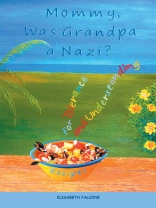Time seems to stand still when we share a meal with family and friends or with strangers. The concept that food releases a chemical reaction enhancing our capacity for tolerance and understanding is a common thread in the stories of this book. They take us from WWII Germany to present-day Europe and America .
When the author’s daughter, Angie, comes home from school and asks, “Mommy, was grandpa a Nazi?”, the author wants to find who wants to know and meets with Angie’s teacher, Ruth Singer, who is teaching about the Holocaust. They have much in common, and their love of cooking leads to a lifelong friendship.
“Gita’s Diary” is about a Polish refugee whose culinary skills help the author’s grandmother and her children to survive while the grandfather is in a Nazi labor camp.
In “Gentiles Only”, Ruth Singer discovers that in the 1950’s Jews are not welcome in some Miami Beach hotels.
“Forbidden Love” is about Silke, a Norwegian immigrant, who falls in love with Julian, a Black man. She learns that in the 1970’s racially mixed couples are taboo in America . They separate, but a cousin’s magic cooking reunites them.
Paul, an American art student in “Aix Marks the Spot”, abandons his prejudice against the Irish when a young Irish pastry chef serves him a delicious dessert.
Soon after the 9/11 attack, Claudia, a Catholic Latina, meets Azir, a Muslim, on a cruise ship. In “Plain Couscous” they set aside their religious differences to enjoy each other and Claudia’s picnic.
“Mutti’s Story” and “Vati’s Story” helped Angie to understand her grandparents’ experiences during WWII.
The stories’ recipes are listed at the end of the chapter. Complete recipes are in the Appendix.
A propos de l’auteur
Elisabeth Falcone was born in Berlin, Germany, two months before the end of World War II. After immigrating to the United States in 1959, she learned to adapt to the American culture.
Having completed her foreign language studies and receiving an M.A. in Linguistics from Florida Atlantic University, she became an educator. Whether in the classroom or on television, she has exposed her students to ethnic diversity by sharing with them her insights into other cultures, as well as the “authentic materials” she gathered on her worldwide travels.
Her immigrant background has made her acutely aware of the way we interact with people of other ethnicities as we endeavor to find similarities that connect us. Along the way, she has discovered that cooking, one of her hobbies, provides a delicious way of achieving harmony among people. Recipes for multi-ethnic dishes appear in this book.
She and her immediate family live along the East Coast of Florida.












